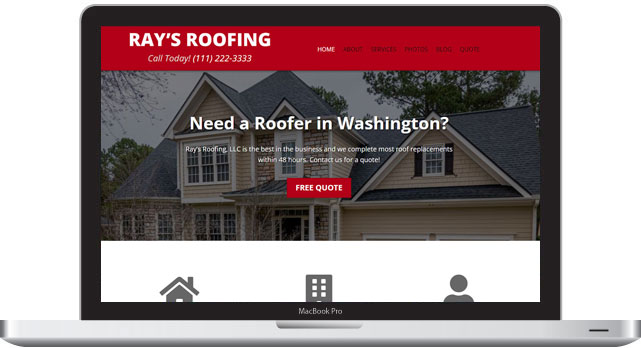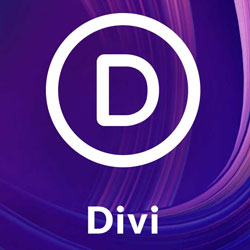Do you have experience with web design? Have you made your first dollar with your skills?
If you answered yes to both, the entrepreneurial bug has hit you. That’s how I felt when I got my first paid job.
The client was a local contractor who did work for my parents, and my dad told him that I built websites. It was a basic 5-page HTML website, took one night to create, and I made $100/hour on the project.
At that point, you realize how much control you have over your income when you work for yourself, compared to relying on a web designer fixed salary.
Even if you haven’t made money yet with web design, when you have an above-average skill, you deserve to put cash in your pocket when you offer your services.
That task is daunting to every WordPress website beginner, especially those who want to take it to the next level into sustainable monthly income.
That’s why I want to talk about what to consider when you develop a web design business plan.
Start A Web Design Business
Target Your Business Niche

The most significant mistake I often encounter is people who want to cater to ALL types of businesses, thinking it will broaden their horizons and maximize opportunities.
However, this approach is a critical pitfall for a web designer.
Picture this… In a fiercely competitive market, where every business is vying for an online presence, your sales messaging needs to be razor-sharp and hyper-targeted to capture the attention of potential clients. Unfortunately, many clients I’ve worked with have voiced their frustrations about endless sales calls and cold emails from web designers, digital marketing experts, and advertising specialists – all offering vague, generic services.
This broad competition is why you need to consider the concept of a “business niche.” It’s about narrowing your focus and aligning your passions, best skills, and creative expertise to become a specialist in a particular field.
Let’s delve into it with an example:
Imagine you build websites for Italian restaurants exclusively because you grew up having Sunday dinner with lasagna and garlic bread at your grandma’s house.
By making this choice, you transform into an expert in this niche. Your conversations with potential clients now carry weight as you speak their language and understand their unique needs. You have a compelling story that will immediately connect with the owner or manager of that business. You can engage them in discussions about implementing a reservation system, strategies to grow their email list to attract more diners, and even showcase specific examples of how their website and online menu will look.
By honing in on a niche that genuinely interests you, you’re not just offering web design services. You’re offering tailored solutions designed to meet the precise requirements of Italian restaurants – which is quite different than what a B2B manufacturing company might need in a website.
This specialization sets you apart from the sea of generalist web designers and positions you as a trusted expert in your chosen field. Ultimately, that’s what clients want – someone who understands their business inside out and can deliver results that align with their unique goals.
The added benefit is that you’re also standardizing your work, which dramatically increases your productivity and the amount you can earn since you don’t have to start from scratch every single time.
Moreover, the most potent way to grab a potential client’s attention is by showcasing tangible results for a similar business. This is why specializing within a specific industry is a winning strategy.
Pick Interesting People
When it comes to picking the right people to work with, it’s not just about finding web design clients – it’s about identifying the type of person who resonates with you on a deeper level. One of the most effective strategies is to look for individuals or businesses that share your values or interests.
Imagine this scenario…
You’re preparing to reach out to a potential client with a cold email or call. While that initial contact might seem daunting, having a common connection can work wonders in breaking the ice.
For example, in my experience, chatting about health and wellness regularly with my website clients has been a game-changer. These shared interests have fostered trust and rapport as we embark on collaborative projects.
It’s more than just business. It’s about building relationships that last for years.
Now, let’s talk about a crucial aspect of client selection – learning about someone’s true nature when you’re in the thick of a project. After crafting websites for diverse clients, you start to discern the traits of great clients and those that might pose challenges. It’s a skill that develops over time, one website project at a time.
As you gain experience building your first handful of websites for clients with varying personalities and preferences, you’ll develop a keen sense of your ideal clients. Then, you’ll become better at selecting similar individuals or businesses that align with your work style and values. This evolving ability to pinpoint the right clients will significantly impact the success and satisfaction of your web design projects.
You can do nearly identical work for two clients. One person might hate it, while the other will love it. It’s a harsh lesson but also helpful so you don’t underrate the skillset you bring to the table!
Business Industry Examples
Are you still curious about the types of local businesses you might want to partner with? Here are a few that I’ve worked with over the years (eventually settling on the home service industry):
- Kitchen Remodeling
- Dance Studios
- Restaurants
- Tree Service
- Auto Maintenance & Repair
Get results for one business and measure it using Google Search Console, Google Analytics, and Google Business. You then have evidence of the results that are possible with a great online web presence for a local business.
Plenty of flaky freelancers are out there, so you can easily set yourself apart by being detail-oriented and creating professional-looking reports that you can send or discuss with your clients every month or quarter.
15 Tools to Start Your Web Design Business
Want this helpful free giveaway or training?
Competitor Analysis

There are so many ways to get a website today. However, you’re likely to find certain trends when you search for web design businesses that have clients near you.
Web Design Companies
Are you ready to dive into the world of web design solutions? There are various avenues to choose from, each catering to different needs and budgets. Frankly, this is what makes it so challenging to provide an estimate of what a website costs!
Let’s break down the main categories:
DIY Website Builders
Examples: Squarespace, Wix, or templates available with your hosting company.
Cost: Typically less than $50 per month.
DIY website builders are perfect for the budget-conscious entrepreneur. With user-friendly interfaces and a range of templates, these platforms empower you to create a website that suits your vision. They are ideal for individuals or small startups looking for an affordable web presence.
Affordable Small Business Solutions
Examples: Companies with less than three people, often just one. They may serve several clients within a specific industry or locality.
Cost: Typically involves a one-time setup fee followed by monthly payments ranging from $100 to $500.
Small businesses often want more website customization and aren’t interested in learning how to implement their visions themselves. These solutions cater to their unique needs, ensuring your website stands out from the crowd and taking the features they like from their top competitors who are a step ahead of them online. They are an excellent choice for local businesses or individuals seeking a professional online presence.
High-End Freelancers
Examples: Seasoned professionals with years of experience and a specialized skill set, such as success within a specific business niche or expertise in e-commerce development.
Cost: Ranges from $1,000 to $10,000. They may have a maintenance contract or hand the website off for the end-user to manage it themselves after launch.
High-end freelancers bring a wealth of knowledge and expertise to the table. They excel in delivering tailored web solutions that align with your specific goals. These experts are perfect for businesses seeking an edge in their online presence who don’t have the budget of a large corporation.
Digital Agencies
Examples: Companies offering a comprehensive suite of high-end services, often staffed by ten or more employees.
Cost: Typically falls between $10,000 to $50,000, often involving contractual agreements and a multi-month project timeline.
Digital agencies are your one-stop shop for top-tier web design and development services. With a team of skilled professionals, they provide end-to-end solutions, from concept to execution. Digital agencies are the go-to choice for enterprises seeking a robust online presence and long-term partnerships. They usually have dedicated salespeople, project managers, web designers, graphic designers, and software specialists.
When selecting a web design solution, a business must consider its “must haves”, budget, and long-term goals.
For instance, a startup roofing company has no need to hire a digital marketing agency. They can start with a simple brochure-type website and expand as their business grows.
The main takeaway is that if you’re starting a web design business from scratch, you don’t want to align yourself with the lowest prices in the market because you will become a commodity and won’t have the profit margin to offer the personalized service that is often necessary to gain traction as a newbie freelancer.
You have to shoot for high volume if you’re slashing prices, and that doesn’t suit most people — especially introverted creative entrepreneurs!
Find your niche between small business solutions and digital agencies.
Avoiding the Comparison Trap
It’s human nature to compare ourselves to others, especially on the internet, where you can uncover thousands of other marketing “experts” aggressively promoting their products and services.
You might find yourself scrolling through successful websites, reading about other designers’ achievements, and, inevitably, feeling like you’re not measuring up. This is when “imposter syndrome” tends to creep in – that nagging feeling that you don’t belong or that you’re not as good as your competitors.
But here’s the thing…
Comparing yourself to others can be a slippery slope. It’s essential to remember that everyone’s journey is unique. What works for one web designer might not work for you, and vice versa. Embrace the idea of an abundance mindset – the belief that there’s enough success to go around for everyone. Your competitors are not your enemies. They can be sources of inspiration and learning.
Remember, you possess a set of unique skills and experiences that no one else has. These are your strengths and your selling points. Plus, there’s a market for every budget and skill level that we just went through in the last section.
Instead of fixating on how you measure up to others, focus on honing your craft, reaching out to potential clients, and delivering exceptional results to those who pay for your services.
One valuable approach is to study the services offered by local competitors. It’s not about copying them but rather using their success as evidence that you have what it takes to offer similar services. It can boost your confidence and show potential clients that you’re on par with the competition.
Moreover, you can (and should) draw inspiration from competitor websites and templates. Analyze what works well and incorporate those elements into your designs. This isn’t about imitation or straight copying. It’s about staying attuned to industry trends, testing your skills, and adding features that your clients want.
If you find yourself in a negative emotional mindset because of imposter syndrome, it’s important to stop bombarding yourself with competitor research. Take a break and focus solely on filling your calendar with productive tasks.
You are generally not in an anxious state when you’re actively engaged in creative work. That comes when you’re thinking too much about the past or future!
Your Web Design Workflow

While you can go the manual route of hand-coding a website, I’m partial to self-hosted WordPress, a platform that powers an enormous portion of the web and makes it easier to manage websites over a long period of time – especially when it comes to adding posts, pages, and photos.
How to Create a Client Website
Starting a web design business doesn’t require a massive upfront investment. In fact, it’s a low-cost venture that hinges on a few essential tools and services. Here’s a breakdown of what you’ll need.
Domain Registration
Price: $20/year
Your journey begins with securing a domain name for your client’s website. This is their online address, so choose wisely. It’s a modest investment for the cost of a few coffees that pays dividends in establishing a professional online presence.
It’s easiest if you bundle this purchase with your web hosting, though you can choose two different companies if you prefer.
Web Hosting
Price: $300-$500/year
Web hosting is the foundation of any website. It’s where your client’s site will reside and plays a crucial role in its performance.
The cost above is an average bill if you go with an “unlimited” plan, meaning you can setup as many domains as you want on a single hosting account.
It’s even cheaper if you’re starting with 1 domain & website.
You don’t need to splurge from day one. Upgrading hosting is much easier today than it was 10-15 years ago, and a local business website doesn’t require the same crazy specs that a worldwide blog with 100,000+ views a month would demand.
Not to mention that you have a lot of control over optimizing a WordPress website to make it blazing fast with budget hosting.
Start fast for less, and grow as you go.
My favorite affordable web host for beginners is HostGator!

Launch with HostGator
Setup WordPress in minutes! 👇
Start NowI may earn a commission if you purchase using my links which helps support this website.
Premium WordPress Theme
Price: $50-$300
To craft exceptional websites, you’ll want a premium WordPress theme that makes it easier to build awesome layouts.
These tools provide better customization options, advanced features, pre-made templates, and customer support that streamline your design process from idea to launch.
WordPress has completely overhauled the way you create with free themes in the last few years using a new feature called “full site editing”.
Installing free block themes lets you create your own templates visually. This functionality mimics the best premium themes on the market.
However, I still think it’s lacking in some areas and doesn’t give you enough control compared to the other premium page builders available. As a web designer, you want something that more professionals use and offers more design power compared to a basic block theme.
So what theme do I recommend?
Divi by Elegant Themes stands out as my top choice. It’s a versatile, user-friendly theme suitable for both beginners and seasoned designers.

Divi Visual Builder
The #1 WordPress theme on the entire internet to design your website with drag-and-drop!
Buy NowI may earn a commission if you purchase using my links which helps support this website.
I settled on a different theme years ago but switched to Divi recently because (1) that theme became obsolete and they stopped development, and (2) upon surveying my subscribers, Divi was by far the most popular among WordPress users like you!
It has since become an integral part of my web design toolkit, and I use it on all new WordPress installations.
This blog you’re reading now is powered by Divi, too!
To master Divi, I recommend delving into my comprehensive tutorial on how to make a local business website with Divi. This step-by-step video will help you harness the full potential of this powerful theme.
Productivity Apps
Efficiency is key when managing a web design business. Streamline your workflow by integrating your favorite productivity apps into your toolkit.
Mine include:
- Google Drive (free) — Collaborate with clients and use it to organize your documents and spreadsheets.
- Dropbox ($120/year) —Share large files and access them from anywhere, ensuring smooth communication with clients.
- Adobe Creative Cloud ($650/year) — Unlock a world of creative possibilities with Adobe’s suite of design tools like Photoshop, Illustrator, and Premier Pro.
Today there are plenty of alternatives, both cheaper and more expensive/robust, for any software tool you can think of, for example, Canva is a great option for graphic design if you don’t want to learn Photoshop.
Web Design Business Models

Selecting a suitable business model is like charting a course through uncharted waters.
Each model, be it hourly rates, contracts, or package pricing, carries its distinct set of advantages and challenges. There are web designers who make each model work and those who have failed in each. The devil is in the details, as they say.
Contracts offer commitment, but you may face hurdles when communication falters. Hourly rates provide flexibility but only sometimes long-term loyalty. Package pricing is easy to understand but might not allow custom development or creative freedom.
We’ll explore each avenue for monetizing your web design business.
Hourly Rates
Like most freelancers, I started with hourly pricing for my web design services. This business model offers greater flexibility since you can work on several projects simultaneously, solve unique problems, and adjust the scope of work as needed, provided you maintain clear communication throughout.
One significant advantage of hourly rates is starting small and upselling clients into ongoing monthly website maintenance (we’ll discuss that soon).
This escalation is what I did to win over clients who have stuck with me for almost 15 years now!
The downside of charging hourly is that the final cost will be unknown to both you and the client. This can result in “sticker shock” when you invoice them the final amount.
Contract Work
Contracts can be a double-edged sword when you are pricing your web design services. While they provide a sense of security and commitment, they can also pose challenges when unexpected problems arise.
My contract experience includes two clients who failed to follow through on their projects despite signing on the dotted line.
These contracts represented a substantial sum — approximately $2,000 combined.
The issue didn’t lie in the contract verbiage but in the communication breakdown on the clients’ end. They gradually became unresponsive as we neared the finish line, leaving the projects in limbo.
In this situation, I questioned whether it was worthwhile to involve a lawyer since I lacked the knowledge and resources to pursue legal action.
Was it worth spending days or weeks and an unknown amount of money to collect $2,000? For me, the answer was no since I had already collected roughly the same figure from the initial deposits and still earned a decent hourly rate with half of what I was owed.
This story would have been entirely different if the sum was $20,000!
Ultimately, these two experiences led me to reconsider contract-based work.
While contracts undoubtedly have their place, especially in complex, high-value projects with inherent risks, they didn’t align with my preferred business model.
I sought a more flexible approach to building lasting client relationships and fostering trust, not resorting to stressful litigation.
Package Pricing
Building client loyalty is a cornerstone of a successful web design business. One effective strategy I employed was package pricing, which allowed me to offer comprehensive web design solutions while nurturing ongoing relationships with my clients.
By picking one niche, I was able to “productize” my services into three package options that required very little custom work or unknowns that could throw a wrench into launching a website.
Nowadays, I only work with clients who want me to manage their websites. I rarely build for a one-time fee and then hand off the WordPress website to them.
To strengthen these partnerships, I include robust analytics reports to show them all the leads generated from their websites and offer occasion in-person (or Zoom) meetings to present this information or let them ask burning questions they have about their online business.
Clients began to view me as an integral part of their team rather than an outsourced freelancer.
This monthly arrangement works wonders for building trust and solidifying a long-term working relationship. It is a win-win scenario because they get continuous feedback and effort to improve their online marketing results. At the same time, the monthly recurring revenue you generate becomes the cornerstone of your freelance web design business, ensuring long-term sustainability.
When new tools and strategies arise from the evolving nature of the internet, you can gradually increase the monthly fee and adapt your services to provide enhanced value to clients. This approach reduces your dependence on constantly acquiring new clients for one-time projects and creates a predictable income stream that you can depend on monthly.
Upsell Your Current Clients
As you gain new skills, you can increase your income by offering services such as business reputation management, SEO improvement, link-building campaigns, email marketing, e-commerce, video, content strategy, and advertising management.
You must invest in education to learn and keep up with the latest trends on the web.
Last but not least, make sure to over-deliver when it comes to communication. In my experience, it’s common for clients to have bad past experiences with unreliable web designers.
The most common complaint is NOT a lack of technical ability, but seemingly simple tasks that did not get taken care of promptly.
The bottom line is to tell your clients what you’re going to do and how long it will take to complete, then give it to them early to earn extra trust points.
15 Tools to Start Your Web Design Business
Want this helpful free giveaway or training?
What are Your Long-Term Goals?

Many people have dreams when it comes to quitting their job, making money freelancing and starting their own web design business.
However, it’s easy to get stuck in the big-picture phase and lose focus on the daily steps it’ll take to achieve your goal.
Be Realistic with Your Situation
Ultimately, your goal is going to be unique to your circumstances.
Maybe you’re 35, have a good job, just starting a family, and you want to make an extra $5,000 from your hobby to help ease the new mortgage payment.
Or you could be a college student who doesn’t feel a passion for their major, and you want to use any free time you have to build the skills to run your full-time web design business after you graduate.
With a monthly service structure, work backward from your financial goal to estimate how many people you’ll need to contact.
Sales is a numbers game.
You must reach out to a large number of people to generate a little interest. Depending on your method of attack, you will be lucky to hear back from 2% of them. That can be a discouraging feeling.
You must trust and refine your process instead of worrying about short-term results.
Make sales prospecting and networking a habit, and think of it as planting seeds that may blossom down the road.
Accounting
Use software to make things easy when tax season rolls around. A few popular online solutions include Wave and FreshBooks.
Right now, I’m using an older version of QuickBooks which does a great job but is not the easiest to learn. They also have a newer online option which might work well for you.
Even if you rely on a simple spreadsheet, tracking your costs somewhere in an organized fashion is essential to managing your money better with each new client.
You’ll also want the ability to send clients a professional invoice.
Proactive Sales Strategy

Now we come to the most challenging aspect of freelancing – landing new web design clients.
You must realize an inconvenient but harsh truth of building any business…
Fulfilling your service (i.e., creating a website) is EASY compared to the art of selling yourself!
With web design, you are working towards a result that you have total control over.
With sales, you’re dealing with people who have unique personalities, objections, questions, and expectations of your work.
Implement an Outreach Process
Let’s not overcomplicate things. To make money, you need to talk with more prospective clients.
That means connecting with decision-makers must be a primary component of your schedule.
Please keep it simple and select a channel that suits you, whether it’s cold emails or cold calling. You don’t want to write a novel or 3-minute pitch about you for cold outreach. The shorter, the better.
You also want to avoid including links in a cold email since that can flag your message and send it to the spam folder.
Your goal is to make it easy for them to respond to discuss further on the phone or set up an in-person meeting.
Track essential metrics like the number of responses per email or phone call to be objective with what’s working and what needs revising.
Create a simple script to guide you, but don’t become a slave to it during a genuine conversation. Allow your curiosity to lead the discussion and ask questions that pop into your mind about their business.
It’s best to start with your local community because meeting face-to-face is an enormous added value and trust booster.
They’re more likely to say “yes” and write you a check on the spot!
Local Networking
For those starting their journey in web design, the power of local networking cannot be overstated. It’s not just about finding clients. It’s about forging meaningful connections and building your reputation within your community.
Consider joining your local Chamber of Commerce and actively participating in their meetings. These gatherings are ideal for meeting fellow entrepreneurs, business owners, and potential clients. By being part of such a respected institution, you gain credibility and trust from the outset.
Online platforms like Meetup are another way to connect you with local professionals and organizations sharing your interests.
Unlike global freelancing platforms that usually skew towards people shopping for the lowest cost, these local associations foster collaboration among neighbors. They emphasize the importance of word-of-mouth referrals and the trust of working with someone in your town.
This shift from the global to the local can be a game-changer for your budding web design career.
Don’t Forget to Follow-Up
Most importantly, you have to follow up on all non-responders and be exceptionally aggressive (in a diplomatic way) with “warm leads” that show immediate interest in your service. Otherwise, that warm lead will be cold in a week.
When you exceed a small transaction, say anything that costs over $100, you will encounter resistance before a person pulls out their wallet. Put another way, you’re not getting an impulse buy! They crave reassurance in many ways, and you’ll need to get on the phone to close the deal.
If the business owner is still deciding, but you never check-in, they will likely forget about you and move on. Conversely, if they are interested but indecisive, you are helping by pushing them to say yes or no definitively.
Stay top of mind, follow up with advice that shows you are the right person for the job, and reach out through all possible channels – email, text, phone, direct mail, in-person.
A beginner mistake is the attempt to outsource sales. You do it because you want to avoid the hard part, especially if you’re introverted like me and don’t enjoy constant social interactions.
I tried getting friends to sell my services, which was a total failure.
It wasn’t because the people I recruited were incompetent. It was because they didn’t have a passion for web design and were NOT inherently motivated by sales commission with no salary.
Outsourcing also requires you to train them. If you have yet to succeed yourself, you’re probably not giving them a template for success.
Ultimately, success is all on your shoulders when starting a web design business.
Your business is your baby, and you’re the only one who will push through the inevitable struggles onto the path of financial independence.
Final Tips & Takeaways
- Standardize your website creation process for one business industry.
- Use a web design questionnaire for onboarding.
- Follow a quantifiable sales strategy to find new clients.
- Diversify your skills to upsell current clients.
- Always ask lots of questions to show your interest and uncover pain points.
- Solve your client’s most significant problems.
- Take notes when you talk with clients over the phone.
- It’s rare (if not impossible) to be good at everything, so be kind to yourself when progress is slow!
Now it’s time for you to take action and start building your own WordPress web design business!
15 Tools to Start Your Web Design Business
Want this helpful free giveaway or training?

